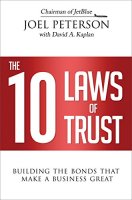
The 10 Laws of Trust by Joel Peterson

Read the summary below and get the key insights in just 10 minutes!

In an interdependent world, progress requires trust. If you can’t trust others, you cannot work toward shared goals. This is true for families, couples, team members and the nations of the world. JetBlue chairman Joel Peterson, writing with David A. Kaplan, details “10 laws of trust.” He explains what trust means, how to promote it inside organizations and how to restore trust when it’s damaged. Peterson addresses the “Valentine’s Day Massacre” of interrupted service that JetBlue suffered in 2007 – and how the company healed the resulting breach of trust with its customers – but he doesn’t explore any more recent difficulties that the airline has experienced. Nonetheless, getAbstract recommends his concise, readable, ethical guide to all who must trust others or earn trust. And that’s everybody.
[/text_block]

- What trust is,
- Why trust matters and
- What the “10 laws of trust” mandate.

Trust Equals Faith
Trust is a basic requirement for all human activity. Trust connotes optimism. To demonstrate trust, you must show faith in someone or something else. That requires ceding control of an aspect of your life to another person, institution or organization. Trust implies voluntary vulnerability. Trust means taking risks, often before you have proof of reciprocity.
Trust implies “enlightened self-interest.” Trust is the social lubricant that eliminates friction. Trust is reciprocal: If you trust people, they usually trust you in return. When trust disappears, interactions break down. With one act of deceit, trust can vanish, often forever.
“Trust is the number-one leadership competency needed today, principally because of how it affects every other competency leaders need to have.” – Stephen M.R. Covey
In most cases, trusting others turns out to be a good bet. Trust enables productive teamwork and cooperation. Protocols, procedures and compliance manuals are of little value in the absence of trust, and suspicions, paranoia and cynicism abound. Trust is vital in today’s peer-to-peer economy, with people increasingly sharing such resources as “cars, boats and apartments.”
Trust doesn’t just happen. It depends on active initiation. People must earn trust. Employees in “high-trust” organizations work together in a cooperative, agreeable atmosphere because they respect and believe in each other. Shared trust is essential in achieving important goals. High-trust organizations outperform “low-trust” organizations marred by people who argue, backbite and steal others’ work. In the long run, high-trust leaders prevail over low-trust leaders.
“Trust builds over time, fostered not only by decency but also by enlightened self-interest, a recognition that trust works to everyone’s benefit.”
The Necessary Elements of Trust
Trust depends on the presence of three crucial factors:
- “Character” – The people you trust believe that what is important to you will be important to them.
- “Competence” – The people you trust have the expertise to attain goals that matter to you.
- “Authority” – The people you trust deliver on what they promise.
“Granting trust doesn’t guarantee perfect results. Inherent in trusting team members with authority is understanding that even the best efforts can falter.”
Trust comes in three forms:
- “Reciprocal”– This is mutual trust between people who love or care for one another, such as family members and close friends.
- “Representative” – This is trust among people who depend on each other, such as clients who rely on their lawyers or patients who rely on their doctors.
- “Pseudo–trust” – This is counterfeit trust that develops among people, such as business associates, whose interests align temporarily but who don’t share real respect.
“As a lubricant, trust accelerates decision making, results in agreements that are both durable and flexible, and makes life infinitely more pleasant.”
Levels of Trust
Prisons are entirely “no-trust,” places where coercion and punishment forces inmates to behave. Dictatorships are low-trust settings, because fear compels the autocrat’s subjects to obey. High-trust organizations operate with “duty and love.” They are based on “meaning and mission.” You know what kind of entity you are dealing with by what motivates its people: force, fear or love.
High-trust organizations can devolve into low-trust organizations. When they do, insiders look out for themselves, and things fall apart. However, leaders also can transform low-trust organizations into high-trust organizations. Try to work with people who exhibit character, competency and authority. Avoid pseudo-trust arrangements and beware that if trust dissipates, betrayal can flourish.
“Out of respectful debate and dissent can grow the best strategy and product, as long as everyone agrees after a decision has been made that they’re all rowing together. ”
Make these “10 laws of trust” central to your organization:
”Law 1: Start with Personal Integrity”
Promoting an organization as ethical only works if the leaders demonstrate integrity. If employees don’t see their senior executives as trustworthy, they will ignore efforts to impose a system that promotes honorable behavior. Employees depend on their leaders. To sustain that trust, leaders need to align their actions with their words. Besides being sincere, leaders must be competent and must execute efficiently.
“Trust wilts in the presence of leaders who absorb the limelight. It grows when they reflect it on their team members.”
“Law 2: Invest in Respect”
Leaders should show respect for all employees. Leaders should listen, without filtering everything through their own agendas, to everyone, from senior managers to the lowest-paid workers. Leaders should empower their staffers and encourage feedback from everyone, not just their top advisers.
In the best organizations, employees interact easily. For example, Google purposefully put the tables and chairs in its employee cafeterias in lengthy, tight rows. Employees bump into their colleagues when they get up or sit down. This is the “Google Bump,” which is meant to foster contact and conversation, especially among people from different levels of the company.
“In low-trust organizations, communication is generally wanting. We may know what’s going on in our department, but when it comes to the company’s broader goals, we’re in the dark.”
“Law 3: Empower Others”
When you give others independence and authority, you demonstrate trust. Google senior engineering director Thomas Williams believes in “grassroots empowerment.” He trusts the employees he supervises to work at their own comfortable pace. “If you work with great people, everyone is setting their treadmill high,” he explains.
The senior managers at Room & Board, a home-furnishings company, permit employees to outline and plan their own performance priorities. Three times a year, employees meet with their supervisors to discuss the progress of their work. The company also allows employees to plan how much time they take off from work. Other enlightened companies do the same. HubSpot’s vacation policy is “two weeks to infinity.”
“It’s little wonder that team members don’t really trust what they’re being told if the targets are ever moving, hazy or en¬tirely unknown.”
“Law 4: Measure What You Want to Achieve”
Employees must know what their leaders expect of them and how senior managers will hold them accountable. Companies that prize accountability make sure that employees understand “what winning looks like.” All goals are precise, as are the firm’s expectations for its employees.
In organizations that revere accountability, senior leaders give credit to those who accomplish their established objectives. These leaders accept responsibility if things don’t go as planned. This is in the spirit of the sports adage, “Players take the wins; coaches take the losses.” Trust disappears when leaders hog the limelight or blame others when projects go wrong.
“Hitching one’s interests to a counterparty can feel like authentic trust, but only until respective interests diverge.”
“Law 5: Create a Common Dream”
Athletes on championship teams share a vision of success. The more tangible the vision is, the more likely the athletes are to accomplish their goals. In organizations, the more inclusive the mission is, the more trust it engenders.
Your organization’s mission must be more than a mission statement. It should be meaningful to everyone your organization touches, without getting mired in “jargon and lofty language.” As a leader, you want to plan objectives that inspire your constituents. Let the members of your team help set out a definitive purpose. When choosing your mission, think big and “think simple.”
“The touchstones of mistrust can slow things down, drive away the most trustworthy people and inhibit innovation.”
“Law 6: Keep Everyone Informed”
Trust depends on communication. Leaders must inform their whole workforce about what is going on within the firm – good and bad. Employee satisfaction can fade in the face of inadequate internal communications. Workers need to know that the firm’s direction benefits them.
Always tell the truth. If things aren’t going well let everyone know immediately. Bad news always comes out; but management’s failure to communicate it on a timely basis makes it worse by generating employees’ distrust. Once trust is gone, it’s extremely difficult to recover. Management should stay as positive as possible no matter what the news is.
“Trust grows when people relate to the mission of an organization and have leaders and employees committed to that mission.”
“Law 7: Embrace Respectful Conflict”
Discord and disagreement are not, in and of themselves, negative. The open expression of different opinions within an organization builds trust. It demonstrates that the company is “an open marketplace of ideas.” Industrial designer Jerry Hirshberg developed the idea of “creative abrasion.” As he explains, organizations can “transform ‘pregnant moments of friction and collision into opportunities for breakthroughs’.”
Such open organizations operate according to a basic principle: “The best ideas win.” Open debate calls for holding a forum for discovering the best ideas, which often turn out to be unorthodox fixes. In high-trust organizations, people want to examine and discuss all options to find the best possible solution. They face up to circumstances honestly, fearlessly and proactively.
“The integrity of leaders is the sine qua non for a high-trust culture, and communication – through words, symbols, budgets and stories – is the fuel they use to power trust in their organizations.”
“Law 8: Show Humility”
Some CEOs believe they are minor deities and act accordingly. Egotism is a huge turnoff to employees. It destroys trust and it’s never appropriate. As the late French president Charles de Gaulle put it, “Cemeteries are full of indispensible men.” Leaders who believe they are irreplaceable focus too much on themselves and not enough on their organizations.
CEOs and other senior leaders should tell themselves: “It’s about the mission, not about me.” They should always honor the achievers in their organizations in a fitting, public way, recognizing high-performing employees in front of their peers and citing their achievements in detail. To earn trust and respect, CEOs and other top executives must be humble.
“People will forgive you for not being the leader you want to be – but never for not being the leader you claim to be.” – ABC News anchor Diane Sawyer
“Law 9: Strive for Win-Win Negotiations”
The best negotiations end with both sides getting something they want. Such negotiations enhance trust, but Zero-sum bargaining inhibits trust. People should never regard negotiations as stand-alone affairs. They should see negotiations in context as a series of ongoing conversations that make participants more inclined to work with and trust their negotiating partners.
As you negotiate, consider what the people on the other side want to accomplish – and respect their motivation. Seeing their interests as legitimate infuses the proceedings with trust.
“Law 10: Proceed with Care”
Niccolò Machiavelli wrote, “It is much more secure to be feared than to be loved.” Employees may fear Machiavellian leaders, but they don’t trust them. Try to work with people you can trust. Choose them on the basis of their character, competency and authority.
How to Recover Broken Trust
People usually assume that those they deal with regularly are honorable and worthy of trust. Unfortunately, you can’t get a guarantee that someone is trustworthy. The best you can do is to associate with people who consistently exhibit integrity and responsibility, and hope for the best.
Despite your best efforts, betrayals may occur. Over the long term, some degree of betrayal is almost certain. It’s an unfortunate hazard – and if it happens, it’ll hurt. Sometimes, betrayal is not personal; for instance, think of how you feel about Lance Armstrong. And, even if someone betrays you, reconciliation is possible.
Though you may not want to accept it, you are likely to bear some degree of responsibility in any betrayal. Fixing things may prove impossible, and it’s rarely easy, but do what you can to straighten out the problem – the sooner the better. Remember that restoration requires restitution and that reconciliation requires forgiveness – which usually benefits the forgiver far more than the forgiven. Never try to get satisfaction from your betrayer. That will only diminish you.[/text_block]

Joel Peterson, chairman of JetBlue, is a consulting professor at the Stanford Graduate School of Business.
[/text_block]

Get key insights from 15,000+ non-fiction books at GetAbstract.com.
[/text_block]













